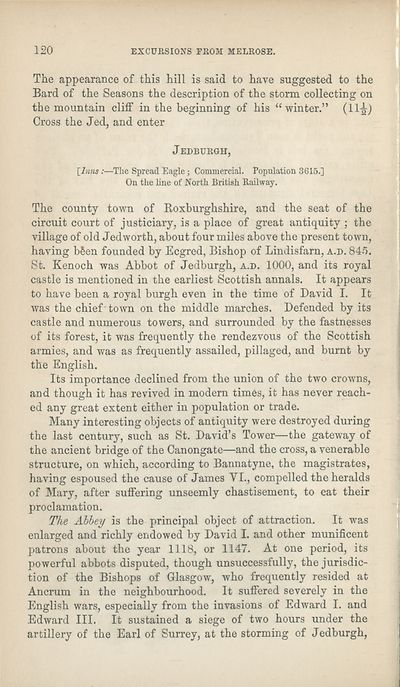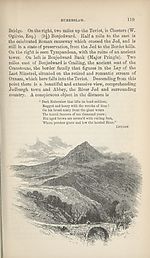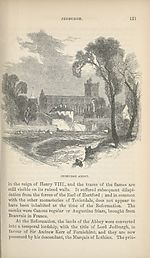Download files
Complete book:
Individual page:
Thumbnail gallery: Grid view | List view

120
EXCURSIONS FROM MELROSE.
The appearance of this hill is said to have suggested to the
Bard of the Seasons the description of the storm collecting on
the mountain cliff in the beginning of his “winter.” (Hi)
Cross the Jed, and enter
Jedburgh,
[Inns:—The Spread Eagle; Commercial. Population 3615.]
On the line of North British Railway.
The county town of Roxburghshire, and the seat of the
circuit court of justiciary, is a place of great antiquity ; the
village of old Jed worth, about four miles above the present town,
having bfien founded by Ecgred, Bishop of Lindisfarn, a.d. 84.').
St. Kenoch was Abbot of Jedburgh, a.d. 1000, and its royal
castle is mentioned in the earliest Scottish annals. It appears
to have been a royal burgh even in the time of David I. It
was the chief town on the middle marches. Defended by its
castle and numerous towers, and surrounded by the fastnesses
of its forest, it was frequently the rendezvous of the Scottish
armies, and was as frequently assailed, pillaged, and burnt by
the English.
Its importance declined from the union of the two crowns,
and though it has revived in modern times, it has never reach¬
ed any great extent either in population or trade.
Many interesting objects of antiquity were destroyed during
the last century, such as St. David’s Tower—the gateway of
the ancient bridge of the Canongate—and the cross, a venerable
structure, on which, according to Bannatyne, the magistrates,
having espoused the cause of James VI., compelled the heralds
of Mary, after suffering unseemly chastisement, to eat their
proclamation.
The Abbey is the principal object of attraction. It was
enlarged and richly endowed by David I. and other munificent
patrons about the year 1118, or 1147. At one period, its
powerful abbots disputed, though unsuccessfully, the jurisdic¬
tion of the Bishops of Glasgow, who frequently resided at
Ancrum in the neighbourhood. It suffered severely in the
English wars, especially from the invasions of Edward I. and
Edward III. It sustained a siege of two hours under the
artillery of the Earl of Surrey, at the storming of Jedburgh,
EXCURSIONS FROM MELROSE.
The appearance of this hill is said to have suggested to the
Bard of the Seasons the description of the storm collecting on
the mountain cliff in the beginning of his “winter.” (Hi)
Cross the Jed, and enter
Jedburgh,
[Inns:—The Spread Eagle; Commercial. Population 3615.]
On the line of North British Railway.
The county town of Roxburghshire, and the seat of the
circuit court of justiciary, is a place of great antiquity ; the
village of old Jed worth, about four miles above the present town,
having bfien founded by Ecgred, Bishop of Lindisfarn, a.d. 84.').
St. Kenoch was Abbot of Jedburgh, a.d. 1000, and its royal
castle is mentioned in the earliest Scottish annals. It appears
to have been a royal burgh even in the time of David I. It
was the chief town on the middle marches. Defended by its
castle and numerous towers, and surrounded by the fastnesses
of its forest, it was frequently the rendezvous of the Scottish
armies, and was as frequently assailed, pillaged, and burnt by
the English.
Its importance declined from the union of the two crowns,
and though it has revived in modern times, it has never reach¬
ed any great extent either in population or trade.
Many interesting objects of antiquity were destroyed during
the last century, such as St. David’s Tower—the gateway of
the ancient bridge of the Canongate—and the cross, a venerable
structure, on which, according to Bannatyne, the magistrates,
having espoused the cause of James VI., compelled the heralds
of Mary, after suffering unseemly chastisement, to eat their
proclamation.
The Abbey is the principal object of attraction. It was
enlarged and richly endowed by David I. and other munificent
patrons about the year 1118, or 1147. At one period, its
powerful abbots disputed, though unsuccessfully, the jurisdic¬
tion of the Bishops of Glasgow, who frequently resided at
Ancrum in the neighbourhood. It suffered severely in the
English wars, especially from the invasions of Edward I. and
Edward III. It sustained a siege of two hours under the
artillery of the Earl of Surrey, at the storming of Jedburgh,
Set display mode to:
![]() Universal Viewer |
Universal Viewer | ![]() Mirador |
Large image | Transcription
Mirador |
Large image | Transcription
| Antiquarian books of Scotland > Scotland/Scots > Black's picturesque tourist of Scotland > (180) |
|---|
| Permanent URL | https://digital.nls.uk/130030350 |
|---|
| Description | Thousands of printed books from the Antiquarian Books of Scotland collection which dates from 1641 to the 1980s. The collection consists of 14,800 books which were published in Scotland or have a Scottish connection, e.g. through the author, printer or owner. Subjects covered include sport, education, diseases, adventure, occupations, Jacobites, politics and religion. Among the 29 languages represented are English, Gaelic, Italian, French, Russian and Swedish. |
|---|

